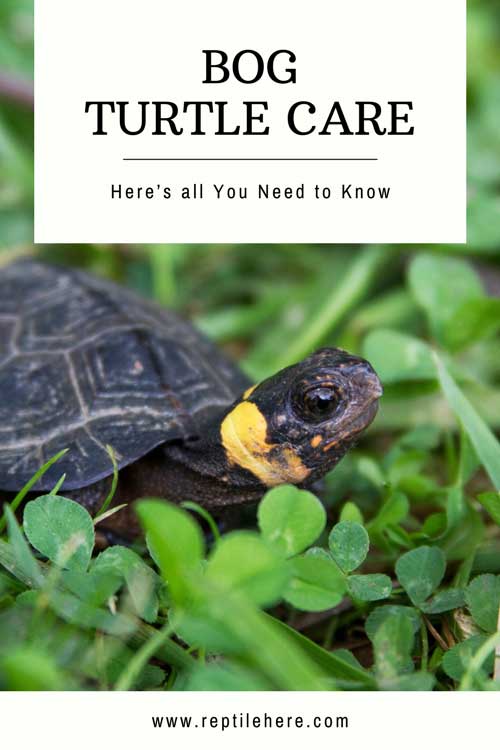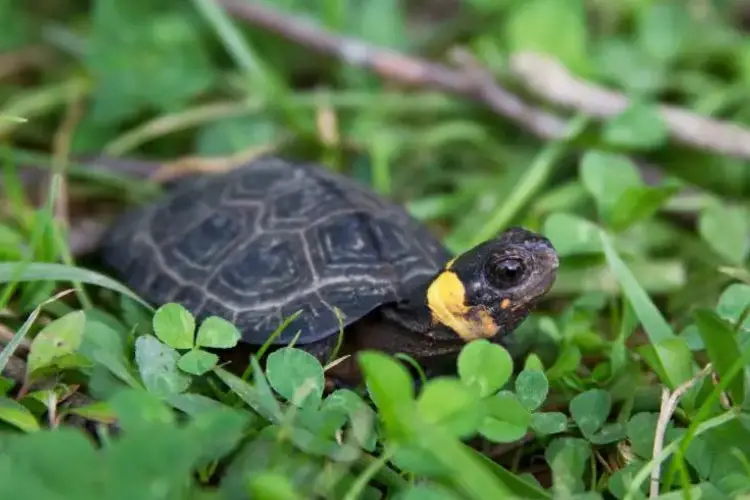Bog Turtle Care – Here’s all You Need to Know
You may be thinking of getting your hands on bog turtles as pets for yourself or a loved one, but don’t know much about them. If you’ve never had a pet before, or more specifically, a turtle, then it can be a little daunting to figure out where to start.
What they eat, their ideal living conditions, and what a bog turtle needs are some things you should definitely keep in mind before going ahead with the decision. Look no further, because we have prepared a detailed and straightforward guide to help you out!
Basic Info About Bog Turtle
Contents
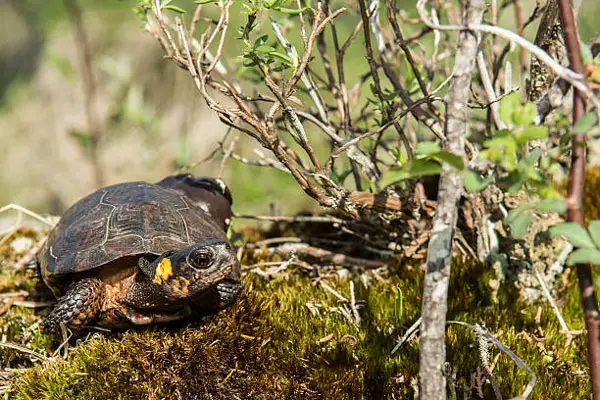
| Scientific Name | Glyptemys muhlenbergii |
| Common Name | Bog turtle |
| Adult Size | 110 grams, 3.7 inches (male), 3.5 inches (female) |
| Max Size | Roughly 4.5 inches |
| Lifespan | Can range from 30-50 years, oldest being 61 years |
| Diet | Omnivorous |
| Range | 250 mile gap between northern and southern population in America |
| Behavior | Biurnal, i.e. active during daytime and inactivity during nighttime |
| Clutch Size | Generally, 1 to 6 eggs |
| Legal to Keep in USA | Illegal in some states and under protection |
| Extinction Status | Critically endangered |
How to take care of your bog turtles
Since bog turtles are naturally habituated to being in the wild, keeping them in confinement or completely new habitats is likely to frighten them. Care of bog turtles, as a result, might just be a handful for some.
Here are the specifics as well as some good tips to follow to ensure your turtles have all they need and there are no risks posed to them or you. These should cover the care they require.
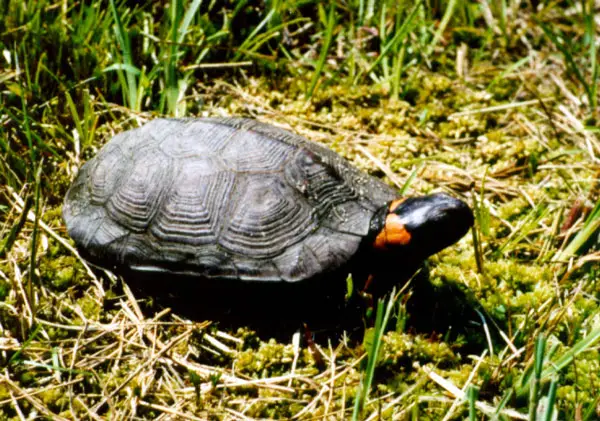
In addition, you might want to make a bog turtle care sheet to hang around the tank for the first few months, so you don’t overlook any important steps.
Your tank
The first thing to prepare is definitely your tank. To pick out your perfect tank, you need to take into account the size of your turtles. Ideally, you want to keep more than half of the tank filled with water, including a dry spot for them to rest and bask. To let them take a good swim without knocking themselves upside down, make sure the depth of water is around double that of your turtle’s length.
Our little friends here are also likely to try and escape their enclosure, this is where the height of your tank also comes to the rescue. A taller wall above the dry floor would make climbing difficult.
Look for tanks with screens fitted on the top, so you don’t suffocate them while keeping them inside.
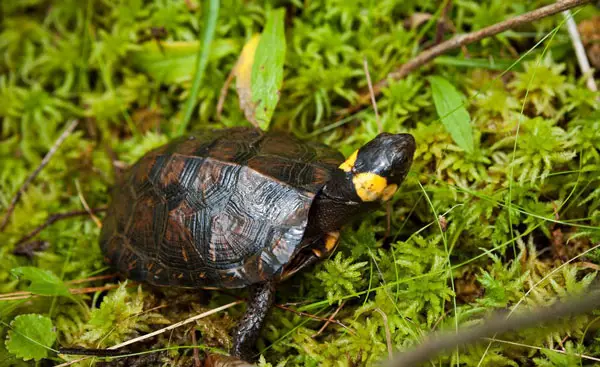
Keep in mind they will need enough space to freely walk around, so try and get your hands on a tank that can house an adult-size turtle with all its requirements without making it feel cluttered. Generally, for a full-grown bog turtle, a 30-50 gallon tank should do the trick. Another general rule is to give one turtle a tank of its own to avoid crowding and aggression between the turtles.
Include some larger rocks or driftwood where they can take shelter when overwhelmed or scared. A hiding spot should let them open up to the new home.
Food
Being omnivores, they have a more flexible diet which should be easy to cater to. For younger turtles, include more protein such as supplements targetted for bog turtles care and pellets rich in protein that can be found commonly in fish stores. There is a chance of their preferences changing as they grow, so pay close attention to their food habits. Adults can consume shred up leafy vegetables such as parsley, lettuce, and aquatic plants. Other vegetables or fruits, such as carrots, can also be provided. Live or dried insects such as worms should be included as well.
Can you keep a bog turtle as a pet?
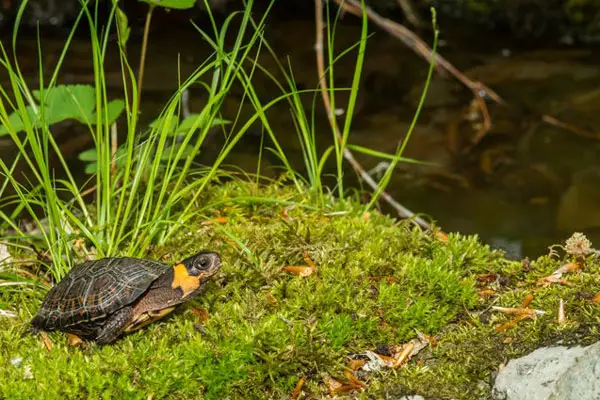
Bog turtles are listed as critically endangered and are currently under protection. Taking in a bog turtle as a pet must be done after proper consultation with local authorities and checking in with pet adoption organizations.
What does a turtle need in its tank
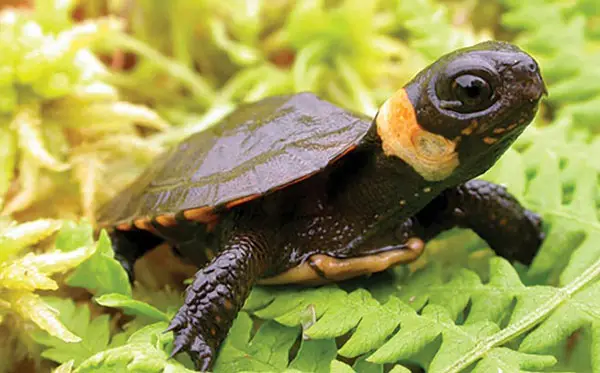
Water
Your tank water will require frequent cleaning. Attaching a water filtration system will increase the intervals for manual cleaning while also making sure your turtles aren’t being poisoned in their water.
To manually maintain the water quality, try to change around 50% of the water every 5-6 days and treat the water to remove harmful chemicals before you add it to the tank. Aquarium test kits are also handy in helping you keep track of the quality.
Temperature and light
Temperature control is very essential in keeping your turtles healthy and thriving. A good basking light should work for both basking as well as provide the proper temperature. Turtles need around 12 hours of basking, increasing or decreasing with the seasons, as well as a sufficient amount of light to incubate their eggs, this can be solved using UV light. Regulate the temperature to around 60 to 90 degrees Fahrenheit to keep them healthy.
Substrate
You have a wide selection at your disposal with a few critical criteria. Ensure that the stone or gravel sizes are more prominent than your turtles so they do not accidentally swallow them. River rocks, gravel, soil, and limestone can all be used. These require cleaning and replacement, too in some cases.
Remember to add a thick layer of mud or soil, this is familiar for them, and they can settle in better. Soil needs to replace every now and then, depending on the conditions, as it can easily decompose.
Health issues surrounding turtles
Turtles can get sick pretty easily and develop a large range of illnesses, familiarize yourself with any infections or diseases they might catch and how you should deal with them. For starters, some symptoms that usually indicate that something is wrong are lethargy, swelling in any part of their bodies, redness, discoloration of their skin or shells, little to no appetite, changes in the way they float or swim, and discharge of any sort.
A good habit to get into is to wash your hands before and after you handle your turtles. Although unlikely, you may transfer germs to them. On the other hand, it’s vital that you wash your hands after touching a turtle or anything in its tank, as it comes with high risks of getting salmonella.
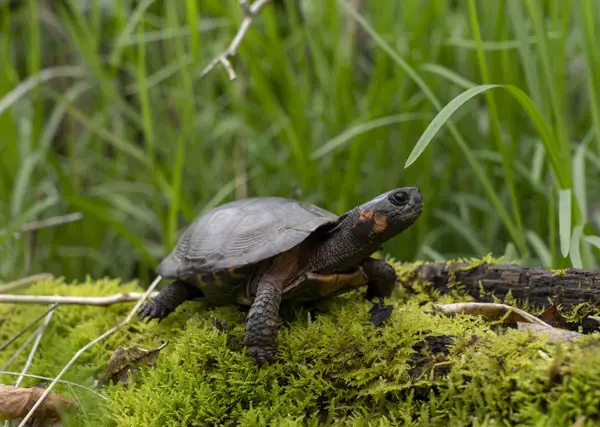
Handle your creatures gently when you have to, as they can easily get hurt. This goes hand in hand with keeping them out of reach of very young children who might be unsuitable to hold them.
Give them a small scrubbing, too, with a soft toothbrush, taking extra care to be gentle so as not to irritate them.
Final Words
You can now say that you are equipped with everything you need to know about turtle care. Taking on an animal, especially a smaller and more sensitive one that demands for exceptionally skilled hands, is a brave task. We believe in hands on experience, but it never hurts to be well-informed, so we hope you feel confident in what you know now!
